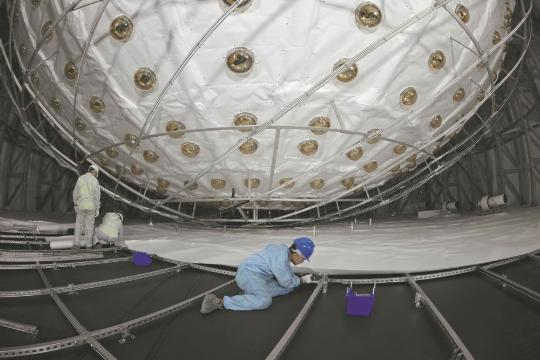Study in darkness shedding light on cosmos
A 20,000-metric-ton sphere, filled with liquid and submerged in a 12-story-tall tank 700 meters below the ground in South China, is being used by scientists to study the mysteries of the universe and how our world first came into being.
The Jiangmen Underground Neutrino Observatory, known as JUNO for short, is located in Jiangmen, Guangdong province, and is tasked with detecting neutrinos, one of the fundamental particles that make up the universe and that are key to scientists understanding it.
Since they were first detected in 1956, neutrinos have been the most challenging particles to study, and significant breakthroughs in neutrino research have been associated with four Nobel Prizes in Physics.
As a neutral elementary particle, neutrinos hardly interact with other matter, making their detection extremely difficult, earning them the nickname "ghost particles".
Neutrinos are everywhere, however, with billions passing through our bodies every second. They move super fast, too, as scientists predict that even a massive entity like Earth can be traversed by neutrinos in just 0.04 seconds.
During the Big Bang, countless neutrinos were generated within the first second, carrying information about the universe earlier than light, scientists say.
"The primary scientific goal of JUNO is to measure the neutrino mass hierarchy and oscillation parameters, which will play a crucial role in testing supernova explosion mechanisms, exploring the origins and evolution of the universe, and discovering new physical phenomena," said Wang Yifang, former director of the Institute of High Energy Physics at the Chinese Academy of Sciences.
Wang said the birth of neutrinos is often related to extreme events in the universe such as the Big Bang, supernova explosions, neutron star mergers and black hole eruptions, with high-energy neutrinos mainly originating from collisions between cosmic rays and dust or gas.
Although neutrinos have existed since the early universe, it wasn't until 1930 that scientists proposed the hypothesis of their existence. It took another 26 years for physicists to experiment with a nuclear reactor and detect the presence of neutrinos.
The plethora of neutrinos remains a mystery to this day. Whether they are massless or have mass directly impacts the evolution laws of the universe, scientists say.
In 2007, China began constructing the Daya Bay Reactor Neutrino Experiment. In 2012, the experiment discovered the third oscillation mode of neutrinos, praised by the international particle physics community as "opening the door to future neutrino physics research" and cementing China's important position in global neutrino research, Wang said.
Neutrino oscillation is a quantum mechanical phenomenon accompanying the generation of neutrinos and is a crucial basis for detecting neutrino mass.
In 2013, preparations began for JUNO, with full installation expected to be completed soon, data-taking to commence next year, and an anticipated operational life span of 30 years.
"The construction of the observatory will bring about significant breakthroughs in neutrino research," Wang said.
The 35.4-meter acrylic sphere mentioned earlier is the crucial component of the core equipment of JUNO — the central detector, surrounded by a stainless steel structure and filled with 20,000 tons of liquid scintillator.
"The main component of the liquid scintillator is alkylbenzene, a raw material used in everyday detergents such as laundry powder and hand soap, posing no harm to humans," said Cao Jun, director of the Institute of High Energy Physics.
When a large number of neutrinos pass through the detector, they react with the liquid scintillator, emitting extremely faint light that is invisible to the naked eye but serves as an important parameter for measuring neutrinos, he explained.
The 45,000"eyes" of the detector receive light signals, convert them into electrical signals, amplify them by a factor of 10 million, transmit them to a computer via an electronic system, and through data analysis, scientists can study the properties of neutrinos.
Cao explained that currently, the only other large-scale projects with significant research capabilities in the global neutrino detection field are the Deep Underground Neutrino Experiment in the United States and the Hyper-Kamiokande experiment in Japan, which are under construction.
Over the past few decades, under the country's unified deployment of relevant departments, the layout of large scientific facilities in the country has gradually improved.
According to the CAS, large scientific facilities in China play a strategic role in achieving high-level technological self-reliance, driving the transformation and upgrading of the manufacturing industry, ensuring the security of industrial chains and supply chains, and promoting high-quality economic development.
Due to the research capabilities of the JUNO, more than 700 scientists and engineers from 74 research institutions in 17 countries and regions have participated in international cooperation.
"Our country's neutrino experiment has made new breakthroughs in design and experimental accuracy, overcoming various technological challenges," he said.
For instance, the team independently developed a new type of photomultiplier tubing, not only reducing costs but also enhancing the detection efficiency of high-intensity light.
"After nearly a decade of effort, the team finally obtained new sample tubes meeting the requirements, collaborated with manufacturers to achieve mass production, broke the international monopoly in this field, and obtained patent authorizations from the European Union, the US, Japan and others," Cao said.
The detection efficiency of domestically produced photomultiplier tubes currently stands at 30 percent, placing it at the forefront internationally, he added.
"Neutrino research belongs to fundamental research, helping us understand how the universe formed and evolved, what the laws governing our natural world are like, serving as the foundation for all possibilities. With these laws, we can gradually turn scientific discoveries into technologies, ultimately benefiting our lives," Cao said.
"In a few years, it may change the world, like Newton's discovery of universal gravitation, Faraday's discovery of electromagnetic induction, and Planck's discovery of quantum energy," he said.

